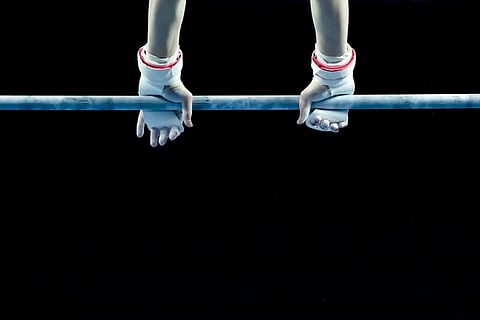

Squinting away beads of sweat dripping down his eyelids, 8-year-old Lokesh is given the entire stretch of the floor mat to perform his vault – a rare occurrence in Tamil Nadu’s government gymnasium.
With a gangly frame on the brink of toning, he sprints to perform a double vault and glances at his coach who shoots him a nod of approval. Touted the prodigal child of the state’s gymnastics team, Lokesh has been training since he was two-and-a-half years old.
“He didn’t win a single medal in the previous national meet though,” says Selvamaruti, his coach. A man in his late 50s, Selva Maruti handles classes for students who practice under the Tamil Nadu Government Gymnastics program.
Although the program gets funds from the state, the coach attributes the lack of recognition from the Gymnastic Federation of India to the most predictable possibility – politics. At the heart of gymnastics in the state is a tussle open for everyone to see – between the Tamil Nadu Gymnastics Association (TNGA) and the Tamil Nadu’s Government Gymnastics program.
The government program is open and free for all and has just one coach for the 100 students ranging from two-and-a-half to 18 years. The Association, however, recognised by the Tamil Nadu Olympic Association has 5 coaches for 15-20 students.
Gymnastics in the state was only recently given the infrastructure it deserved. Until 2014, students had to practice in a tiny 15x15 space. “In the two-and-a-half hours we were allowed to use that space, we spent one hour lugging the apparatus and laying the floor mats,” says Sushmetha, a 16-year-old national level gymnast who is the pride of her coach.
Only two students out of 50 could practice at a time, and many dropped out gradually. A gymnasium was finally opened in 2014 which could hold a capacity of 50 students. Within a month, gymnasts from TNGA and the government program were forced to share the space.
The focus moves from the practice of gymnastics to fighting for space and resources at the gymnasium.
But lack of competition and exposure is perhaps the biggest grouse for these aspiring gymnasts.
Also read: ‘Medals came at risk to my life, no safety gear for training’: Top Karnataka gymnast
Sushmetha feels her promise as a young gymnast is fading after the National Championships were stopped by a court after two factions from the national body announced two meets at two different locations. “After the court declared there couldn’t be two national meets, both meets were called off. We haven’t had any exposure since,” she rues.
But it’s not just factionalism and in-fighting that these amateurs have to deal with while training. Infrastructure remains woefully substandard.
Two young boys position a shaky pummel horse, an apparatus with a metal frame and two plastic handles. Flecks of white powder settle on its rusting frame almost at the end of its life.
Application for a new apparatus is an arduous process, enough to discourage coaches from commissioning any. Two years have passed since a trampoline and a floor mat were dispatched.
“Our floor pit is a high jump sponge thrown into pieces. We train inside the gym with old torn beams. We still have the springboard from 17 years ago. A floor mat broke in four months and we manage to train on broken boards even now. If you thought the risk of injury in the sport was high, the risk is heightened by the apparatus, which easily gives in,” says Sushmetha, exhausted but undeterred by the state of the gym.
The crash mat, the most valuable of the apparatus, detaches from the ground on the impact of a girl landing from her vault. “The foundation is very shaky,” says Selvamaruthi.
It's not just Tamil Nadu, the sorry state of equipment and infrastructure exists across India.
Lokesh Narasimhamurthy, a Karnataka gymnast says, “Dipa's double salto is risky, and if not executed perfectly, runs the risk of splitting the gymnast's spine in half or injuring him or her permanently. I can't risk it on the equipment that is there in Mysuru. the nearest place where I could practice it is Kerala,” he says.
“I have myself hurt my neck, ankle, and fingers many times. The stadiums need foam pits and safety infrastructure, which are currently missing,” he says.
Sushmetha recounts the first time she met Dipa Karmakar in a nationals event in Bhopal. “The beam was extremely unstable, unlike a nationals event which should ideally have the best apparatus. This was an embarrassment for the federation and triggered a huge blame game, but the show had to go on,” she says.
Two women had to hold the beam together from falling apart. But Dipa asked the women to move away and balanced herself in such a way that she held the beam together with her feet, to the amazement of the audience. Sushmetha woefully explains - “When you have coaches screaming at each other in your gym and you fall on your beam because you can’t concentrate, you leave. That’s why we are losing potential greats.”
Wit inputs from Sarayu Srinivasan